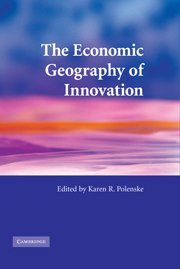Book contents
- Frontmatter
- Contents
- List of figures
- List of tables
- Notes on contributors
- Acknowledgments
- Abstracts
- List of abbreviations and acronyms
- Part I Concepts and measurements in innovation
- 1 Introduction
- 2 Measurement of the clustering and dispersion of innovation
- 3 Measuring the geography of innovation: a literature review
- 4 Employment growth and clusters dynamics of creative industries in Great Britain
- Part II Institutional and spatial aspects of information and knowledge flows
- Part III Institutions and innovation systems
- Index
- References
1 - Introduction
Published online by Cambridge University Press: 22 September 2009
- Frontmatter
- Contents
- List of figures
- List of tables
- Notes on contributors
- Acknowledgments
- Abstracts
- List of abbreviations and acronyms
- Part I Concepts and measurements in innovation
- 1 Introduction
- 2 Measurement of the clustering and dispersion of innovation
- 3 Measuring the geography of innovation: a literature review
- 4 Employment growth and clusters dynamics of creative industries in Great Britain
- Part II Institutional and spatial aspects of information and knowledge flows
- Part III Institutions and innovation systems
- Index
- References
Summary
Introduction
Every day people talk about innovation on the radio and television, as well as in newspapers, books, and popular and academic articles. In May 2004, for example, Alan Greenspan, then head of the US Federal Reserve Bank (FRB) spoke at an FRB conference of the Federal Reserve Board of Chicago on “Globalization and Innovation” (Greenspan 2004). The Boston Globe each Monday since February 7, 2000 has devoted an entire section of the newspaper to the topic of innovation, covering a wide spectrum of sectors, such as biology, information technology, and e-commerce. Even so, these leading conveyors of information, for the most part, neglect the fact that the innovation occurs in space. The product may be conceived in an office, a garage, or on an airplane, but to begin the process of developing the product to bring it to the market, a production facility must be built or located, or a part of another production area taken. The influential authors from the economics, industrial organization, planning, and political science fields I selected to write chapters for this book all help fill this “spatial gap” in the literature. They summarize and critique previous innovation theories and concepts, and provide insights into the spatial concentration and dispersion of innovation. They provide an interesting comparative picture of the institutional factors that underlie innovation systems in East Asia, Latin America, the United Kingdom, and the United States, indicating the vast geography over which innovation occurs.
- Type
- Chapter
- Information
- The Economic Geography of Innovation , pp. 3 - 12Publisher: Cambridge University PressPrint publication year: 2007
References
- 2
- Cited by



